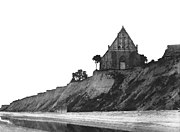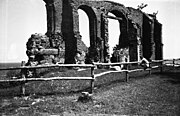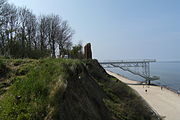Church Of Saint Nicholas, Trzęsacz
Abrasion
Over time, the process of abrasion (more generally known as erosion) caused the land surrounding the church to recede at the expense of the Baltic Sea. Year by year, water would come closer; in 1750 the sea was as close as 58 meters, in 1771 parts of the cemetery were swallowed, and 1820 the distance shrank to 13 meters. Finally, on August 2, 1874, the last service took place in the temple. Afterwards, all furnishings were transported to the cathedral in Kamień Pomorski, with the exception of the triptych, which is now kept in a church in Rewal. By 1885 the temple stood over a chasm and, with permission of the Prussian government, it was deprived of the roof and left abandoned.
On the night of April 8–9, 1901 the most vulnerable, northern wall of the church collapsed. During the following years, part by part, most of the construction was swallowed by the sea, which mercilessly moves south, taking away the land. The last drop took place on February 1, 1994, when part of the southern wall collapsed.
According to scientists, since the turn of the 19th century the sea has taken around 40 centimeters of land a year. Over time, local governments – both Prussian and (after 1945) Polish – tried to save the temple with fascine and concrete blocks, but all attempts were unsuccessful. Currently, intensive works are taking place to save the ruin, as this is the only one of its kind in Europe. One of the projects stated that the last remains of the wall should be moved southwards, further away from the sea, but the risk of complete collapse of the ruin was too high.
Photo gallery
- History of the collapse
-
1870, the church inside
-
1870, the church outside, seen from east
-
1870, the church outside, seen from west
-
1930, seen from east
-
1930, seen from north-west
-
1934, seen from south-west
-
1965, seen from south-west
-
1971, seen from east
-
2009
-
2014, seen from south-west
-
2021
Sources
Polish
- A page about the church, together with historical photos
- http://www.muzeum-trzesacz.pl/trzesacz.htm
- http://www.rewal.pl/trzesacz/trzesacz.htm/ Archived 2007-08-18 at the Wayback Machine
- https://web.archive.org/web/20050112201225/http://www.kroki.ps.pl/miejsca/trzesacz.php
German
- http://www.ostsee-urlaub-polen.de/pobierowo/trzesac_hoff.htm Archived 2007-08-23 at the Wayback Machine
- http://www.hs.ta.pl/plaintext/kategorie3/index.html Archived 2007-09-28 at the Wayback Machine
External links
- Church in Trzesacz, 1870
- A photo of the church, 1909
- Church in 1935
- Ruins of the church, around 1970
- Last remaining wall, 2000s
- http://www.panoramio.com/photo/3579358
- The process of destruction of the church - animation
- Photo Gallery Archived 2014-04-19 at the Wayback Machine
- Kościół św. Mikołaja w Trzęsaczu (ruiny) - Hoffer Kirchenruine, Kirchen Ruine in Hoff na portalu polska-org.pl










